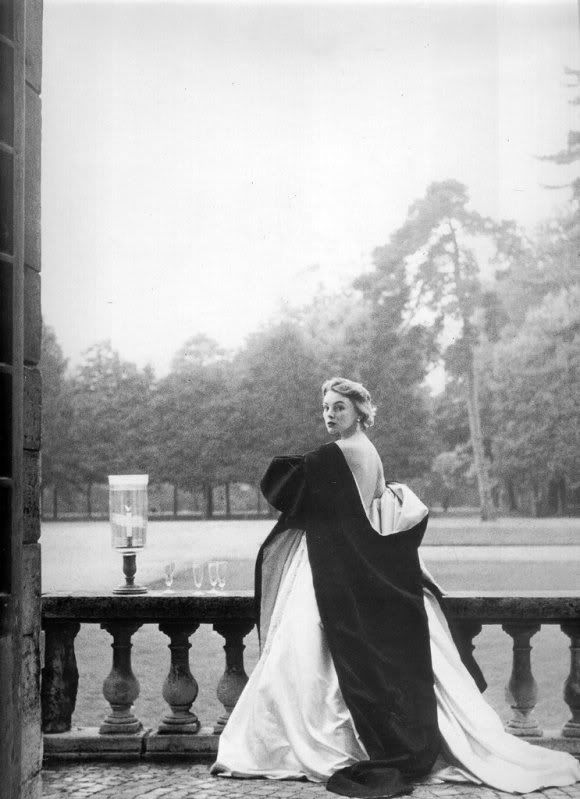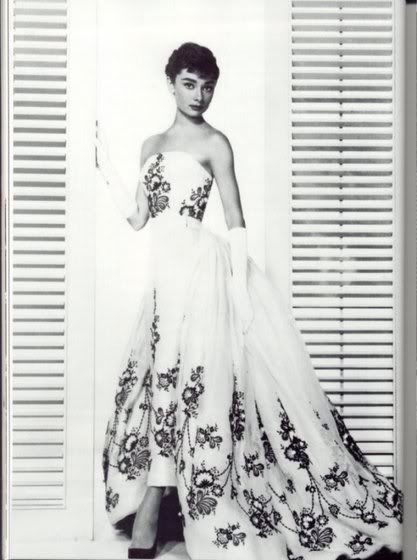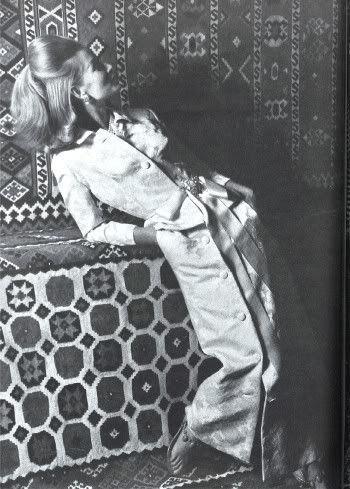
Givenchy gown. Photographed by Henry Clarke, 1952.
In case anyone missed this interview with the rarely seen Hubert de Givenchy, I have extracted the most intriguing sections. He recently curated an exhibition of the work of Cristobal Balenciaga, Philippe Venet and himself that is currently on view at the Château de Haroué, in the Loire valley. I tried to fit a visit to it into my trip to France last week, but it was rather out of the way. If you are in that area, it is on view until August 17th and it is definitely worth a trip as it includes many beautiful pieces including Audrey Hepburn's iconic Givenchy LBD from Breakfast at Tiffany's.
Hubert de Givenchy: 'It was always my dream to be a dress designer'
Extracts from an interview with Carola Long from The Independent, 7 June 2010.
If anyone can offer advice on how to be elegant it's Hubert de Givenchy, but his opening tip isn't entirely encouraging, and lacks the anything-is-achievable democracy that we've come to expect from fashion. "You must, if it's possible, be born with a kind of elegance. It is a part of you, of yourself," he says. Fortunately he also has some more practical hints, saying that "you must keep it simple". He notes that when he goes out in Paris it's the young people who dress in the simplest way who look the best; "and the more pretty you look, the more love affairs you will have," he laughs.
In the half-century since he founded his couture house in Paris, in 1952, the designer has accentuated the natural elegance of some of the prettiest – indeed some of the most beautiful – women of the 20th century, including Grace Kelly, Jackie Kennedy and of course Audrey Hepburn.
The pair met when Givenchy received a phone call saying Miss Hepburn would be coming to see him about the costumes for the 1954 film Sabrina. He assumed the actress would be Katharine Hepburn, because he "did not know who is Audrey Hepburn, because I did not see the first movies". However, when Audrey Hepburn turned up dressed in a knotted T-shirt, flat sandals and a gondolier's hat they had an instant rapport which led to lifelong friendship and her becoming his muse. Initially Givenchy told the actress that "it would be impossible to make the clothes because I have only eight workers and to make 15 or 20 dresses in such a short time is not possible for me". In response "she said, very nicely, 'I want to see your collection, right now,'" he recalls. "It was still in preparation but I showed her and she said, 'this is right for the scene in the station' and so on, and finally we made it possible for me to dress her. From that day on, until she died – too early for me – the friendship was really like a special love affair." The depth of his affection for the actress is quite moving, especially when he gestures skyward and says, not melodramatically, but tenderly, "She is there. Up there."
Audrey Hepburn in a Givenchy gown in Sabrina, 1954.
Of course, Givenchy's life, born to a prosperous family and becoming one of the most celebrated designers of all time, is more gilded than most – positively-24 carat – but this rapturous passion is infectious. Perhaps it's the optimism of someone who fulfilled his dream. He says, "It was always my dream to be a dress designer and that my mother accepted this decision. You are like a butterfly, in every moment you must have good reception [he mimes antennae]; in every moment you must be attentive and notice the little things to be creative. It's a fabulous thing, to give life to fabric, to make something move well, the harmony of colour."
The starting point for Givenchy's creations was always the cloth. "Fabric is the most extraordinary thing, it has life. You must respect the fabric," he insists. His aesthetic was classical, pure and sometimes slightly severe; with an occasional surprising flourish such as the cutaway, crescent-shaped detail on the back of the dress Hepburn wore in Breakfast at Tiffany's. He says today that "the little black dress is the hardest thing to realise, because you must keep it simple."
Born in Beauvais, north of Paris, in 1927, Givenchy arrived in the capital at the age of 17. He started his career working for the dynamic Jacques Fath, moving on to the more classic Robert Piguet, Lucien Lelong and then Schiaparelli. He remains convinced of the values of learning first-hand, from "a master, an example, a great creator – like with painting. You never finish learning in life." It wasn't long before Givenchy was attracting stellar clients and working with the best models, and achieved his long-cherished aim of befriending his hero, Cristobal Balenciaga, whom he considered, "a great architect", because "all the proportions of Balenciaga are strong, modern, wonderful".
Givenchy brocade suit, Vogue 1963.
Asked what he thinks of the Givenchy collections now, the founder is tactfully evasive. He starts by saying, "I think when you sell your company, and are no longer the master of driving it, it's quite difficult," then explains that he is concentrating on working with Christie's, and following his interest in "beautiful things, books, silver, furniture". Too busy to look at Givenchy collections, he says, "I don't think I have any interest any more. It's better like that."
It's clear from his (Oxford University) Union lecture that the designer isn't exactly enthralled by the modern fashion world. He doesn't believe that actresses at Cannes have the "great style" of silver-screen legends such as Carole Lombard or Judy Garland, dismisses some collections as just there to sell bags and shoes, and considers many designers out of touch with reality; showing "impossible, crazy clothes" rather than "thinking about the life of a woman".
Instead he is philosophical. "Every epoch is different, and you must accept the reality," he smiles, "C'est la vie. Happily, for many years we had a wonderful time. Beautiful fabric, beautiful people, beautiful memories." In that order it seems. For Hubert de Givenchy, everything starts with the fabric.
Below is a small video showing the exhibition in situ in the Chateau.

